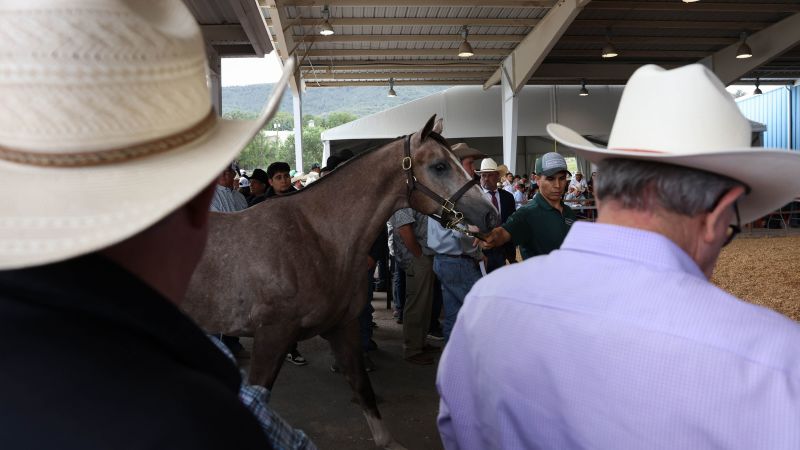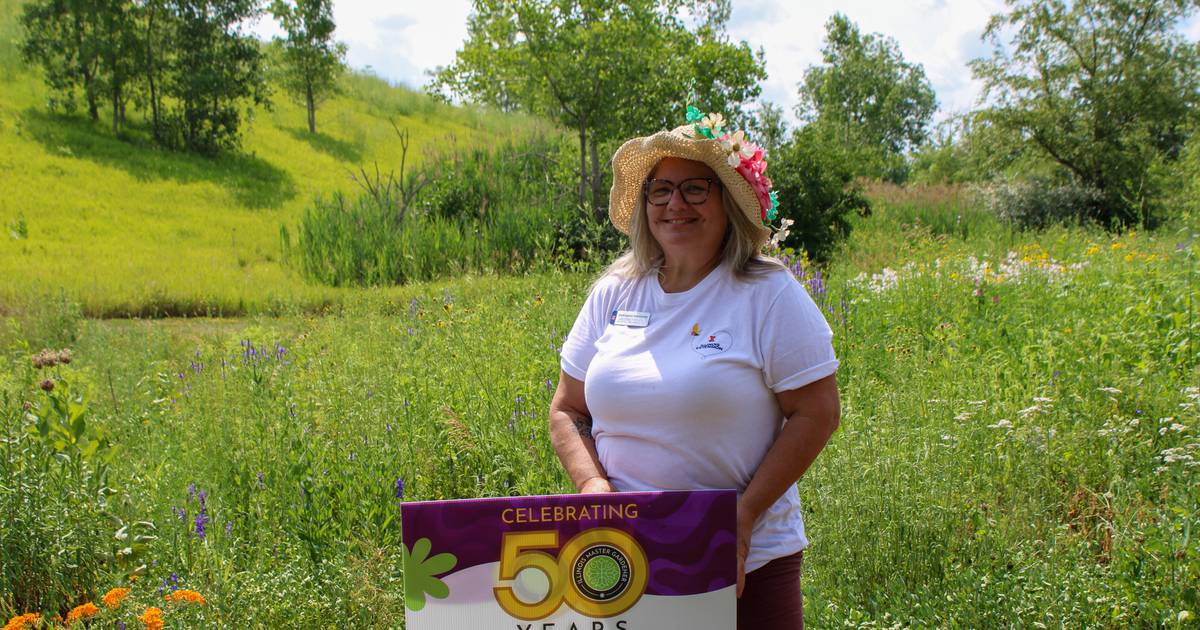In a new era of climate disaster, a tiny, resilient mountain village in New Mexico is teaching the world how to adapt

The soft dribble of rain drapes a herd of cowboy hats as an auctioneer hollers bidding numbers into the mist. A thoroughbred yearling, oiled mane gleaming, skin twitching over taut muscles, struts gracefully as buyers lean forward with hungry eyes.
In Ruidoso, New Mexico, the pounding hooves of racehorses have entranced crowds from across Texas and New Mexico every summer, pumping in millions of dollars from the All-American Derby, Oaks and Futurity races and the steady hum of seasonal jobs that carry this mountain village.
But when the races stop, everything goes quiet.
The colt doesn’t know the racetrack he was bred for – the pride of Ruidoso – lies in ruins for the second year running, gutted by floodwaters that turned familiar dirt into a sucking bog of mud.
And the thousands of people who rely on the track for survival are still stuck in it.
At least three people, including two children, were killed in the wildfire-scarred village after torrential rain triggered raging flash flooding in July, wiping out the Ruidoso Downs Race Track and over 150 businesses and homes, many that had just rebuilt, displacing over 400 people.
Slow-moving thunderstorms frequently unleash catastrophic downpours over the South Fork burn scar, a region still reeling from two fires that scorched over 15,000 acres and destroyed 1,400 structures. The now-barren landscape is vulnerable to severe erosion and sudden, life-threatening flash flooding.
Each downpour brings a renewed threat to disaster-weary Ruidoso, which has been under 13 flash flood emergencies since June 2024.
Rather than risk the destruction of their village with every flood, Ruidoso’s leaders are plotting for survival.
This includes a second attempt to repair the track before racing season begins in next April, in a desperate dash to jumpstart the town’s economic core.
The financial toll from the loss of the track is staggering: Over $320 million in two years gone with the ashes of the fires and swept with the currents of the relentlessly recurring flooding of Rio Ruidoso.
Jockeys, trainers and groomers have taken their expertise to other states. Hotels sit empty all summer, once their busiest season. Local restaurants that serve up green chile-smothered burgers and chicken fried steaks run on fumes, waiting for locals who arrive out of loyalty rather than crowd-driven demand.
On the eastern side of town, the horses have arrived for the annual horse sale. In days, they will be gone, and with them, the only remaining echo of the heart of Ruidoso’s tourism economy.
Above the men and women in matching leather belts and pointed boots, the clouds hang heavy, an ever-present warning.
For a town that lives by horses and dies by the river, every drizzle is now a trigger.
A village of the traumatized and the displaced
On a storm-swollen night, Sam Pirelli clutched his shivering chihuahua and 10-year-old grandson on the bed as water forced open the door like an intruder with vengeance. The flood shoved furniture into walls, sucked photographs from drawers. Memories and childhood tokens bobbed and broke apart.
Pirelli has been left with nothing but fear and the red tape that surrounds him – paperwork, interviews, losses priced in dollars instead of cherished decades in his home, all spinning into a bureaucratic whirlpool.
“I have good days and bad days,” Pirelli’s voice trails off. He stands by Rio Ruidoso, eyes distant, reluctant to speak of the days that bring him to the brink.
He is one of 153 residents still displaced by July’s flooding, just as people were returning to the homes they poured their savings into rebuilding, and the racetrack was finally back in shape.
Now these survivors, including children, sleep in hotel rooms and emptied Airbnbs, as the moldy remnants of their homes decay in silence.
“In the locals, PTSD is a real thing, but the people here are very resilient,” says Lynn Crawford, Ruidoso’s mayor, from his desk inside the town center. He’s recovering from a stroke, and after a bit of prompting, he admits stress likely played a role.
Many locals speak highly of him. “He’s doing his best,” they say. Others are frustrated as they await federal assistance that arrives slowly, if at all. They urge Crawford to speed the process.
He doesn’t blame them for it. After witnessing the constant destruction of his village, he’s tired, too.
“After a while, it just weighs on you … You don’t see the sunshine anymore. You don’t see the joy in life, you start focusing on the tragedy that may happen. What else can I lose?”
Margaret Burton and her husband agree. They’re exhausted, spending half of their time in their other house on the edge of the Chihuahuan Desert, and the rest in the “mancave,” also known as the shed behind their half-wrecked house by the river in Ruidoso.
Burton is angry when she describes how the water changed her. The flood took both her home and her trust. When she remembers how a trailer beside the river was vacuumed into the flood, two children dead, parents barely alive, she swears she can’t look at the river the same way again.
“They were right there, playing over the weekend right before the flood,” Burton said, pointing to the trailer’s bent remnants laying against a tree.
“It’s terrifying. My heart breaks for the parents.”
She keeps a bag of essentials by her door: clothes, medicine, her contact lenses. When the sky darkens, her stomach clenches.
“Anytime we get a warning, I’m not here. We don’t risk it,” Burton said.
Next door to Burton, Nancy Crownover survived by inches. Her home rests on a sliver of a hill, and when the flood came, it stopped at her threshold.
She carries a floppy-eared basset hound puppy in her arms as she tells stories of her neighborhood. One woman found the shoes of the girl who was killed in the flood and was so heartbroken by the trauma, she moved away. Another man’s grandchildren hung on to the ceiling fan to survive.
For months, Crownover has watched looters scavenging the remnants of neighboring abandoned houses like vultures circling bones.
“You just look around and it’s all destruction,” she says, eyeing a masked man across the river entering the ruins of a damaged home. “And to have to contend with the thievery on top of this? I am disappointed in humanity.”
Another neighbor has hammered up a sign in fury: “If this is not your property, stay the hell off it or you’ll suffer the consequences. It takes a real piece of sh*t to steal from folks in their time of need.”
Although several locals spoke to CNN about looters, Ruidoso Police Department Chief Steven Minner told CNN they have received “no reports of looting and made no arrests.”
Despite the destruction and the uncertain future ahead, the three neighbors reject the idea of leaving.
“No,” they each say, shaking their heads stubbornly.
For Crownover, the home, built by her parents 65 years ago, is all she has left of them. Burton looks at her yard and sees memories of family reunions.
For Pirelli, the reason is simple.
“This is my home,” he says. “My home, sweet home.”
Resilience requires community
Behind the dressing room door of Boots and Jeans, Linda Connelly heard a man sob. He’d walked in five minutes earlier, asking for the cheapest boots. He lost everything in the flood, he said, and couldn’t afford much.
The store manager didn’t blink. “Honey, pick anything you want,” she told him, ushering him toward new boots, a button-up shirt and a pair of pants. Every month since, she’s quietly donated boots to racetrack workers, displaced children and anyone who lost more than the water should have been allowed to take.
People like Connelly keep Ruidoso breathing. A church group shows up to restaurants and businesses every Friday, with burritos piled hot in foil, circling in prayer before asking the question:
Who needs help?
The Lincoln Community Foundation has been a lifeline, passing out gift cards and shelter funds to make sure no one slips through the cracks. More than $1.2 million is being distributed to victims, donated by neighbors and kindhearted strangers from all over the country, says board member Leroy Smith.
Neighbors showed up with shovels to clear mud and debris, searching the wreckage for lost treasures – wedding rings, family photos – the floods swept away. Everyone gave what they could, including a child named Rob, who mailed a letter with $4 tucked inside.
“It’s inspiring, almost to the point where it brings tears to your eyes,” Smith said.
Logan Fleharty, a tattoo artist whose parlor sits on Main Street, prints shirts that read, “Don’t talk sh*t, do sh*t,” and hands the money raised to flood victims. During the fires, he stayed and fed every cat and dog left behind. When disaster hisses at Ruidoso, Fleharty shows up in inked sleeves, grinning, grounded and stubborn with hope.
“It’s soul searching,” he says. “You gotta find something that gives to make the world better. It’s our family members, it’s our friends, it’s our neighbors, we try not to focus on negative.”
The resilience finds its lighter notes. At Flying J Ranch, cowboys fire triumphantly into the air during a mock shootout before visitors chow down on chuckwagon beans and cheer for a band strumming guitars and ukuleles.
The business, owned by couple Emily Hobbs and Mickey Bakas, has taken a heavy hit due to the loss of tourism. Despite the empty seats, they continue to show up, singing cowboy classics like the 1934 tune, “Santa Fe, New Mexico.”
“It’s an hour and a half every day that I don’t have to think about what’s going on in Ruidoso, so I get to just do my best for somebody else, and that’s pretty nice for me,” Bakas says, sharply dressed to play his role as a criminal during the performance.
Hobbs, her rich, resonant voice often stealing the band’s spotlight, took over the business as her parents aged. She loves it, but there’s an undeniable weariness in her voice when she talks about the effort required to keep things afloat.
“Some people see the flood coverage, and although they weren’t planning on coming, they know that tourism is our lifeblood, so they came anyways,” Hobbs says. “We’ve seen a really sweet response from locals who have come out four or five times just to help.”
Adapt or lose
In Ruidoso today, there is no illusion. The floods will return – and some will be catastrophic. The burn scars left by wildfires make sure of that, with no trees or grass to absorb the water, and no soil to hold it. But the town has resolved to adapt.
No matter where they are, when the screeching flood warning alarm sounds on their phones, they drop everything to decide: Shelter in place, or race home before rising waters block the roads?
Meanwhile, village leaders do what they can to clean up and keep going. “Adapt or lose” has become the mantra, a survival tactic as much as a philosophy.
The floodplain has been redrawn wider than ever, outlawing home construction in new danger zones. Emergency management blasts out alerts at the first sign of drizzle, warning residents that in the heart of the Sacramento Mountains, one inch of rain can turn into a river of death.
The village’s environment department is repairing treatment plants, restoring watersheds and working on accessing federal aid.
Ruidoso is not an outlier. Across the US, fires and floods are now common in regions that used to rarely face them. Climate-fueled catastrophes that were once anomalies – deadly wildfires in the Northeast, historic urban flooding in the Southwest – are rapidly reshaping the fabric of American life.
Such flip-flopping between weather extremes could happen more often as the world warms due to fossil fuel pollution, climate experts say. Rainfall events are also intensifying; nearly 90% of US cities experienced an increase in hourly rainfall rates since 1970, according to a 2024 analysis from Climate Central.
Department of Homeland Security Secretary Kristi Noem last month announced $11.4 million in disaster relief for the state, adding to a prior $3.1 million in federal aid. More than 160 emergency management staff remain in the area after President Donald Trump signed an emergency disaster declaration, unlocking $2.9 million in funding.
The racetrack, Ruidoso’s legendary symbol and a promise of revival, is being redesigned to be moved farther away from the river that ended it twice.
Perhaps the biggest adaptation is psychological. This town no longer waits for disasters to end; they prepare to live alongside them. They fundraise relentlessly and keep documents, pets and horses ready to move. Visitors are urged to return, assured that yes, disaster happened here, but it hasn’t killed what matters most.
Ruidoso lives on, fierce as the thoroughbred breaking from its gate: scarred already, but running anyway.
Smith, the charity board member, stands in between the long blades of grass that have grown back where blazing fires devoured everything in its path just a year ago. Enveloped in the scent of wildflowers, he points to where the walls of his childhood home once stood. Here were the polished pine floors; there, the guest house; and beyond the trees, his favorite fishing hole.
All that remains throughout empty acres of lush green land are abandoned mailboxes of homes turned to ash. The names of their families have not faded.
Dennis, reads one.
Damin, another.
Behind them, the wildflowers bloom softly from the healing dirt of an earth that has never known a thing besides how to just keep going.



